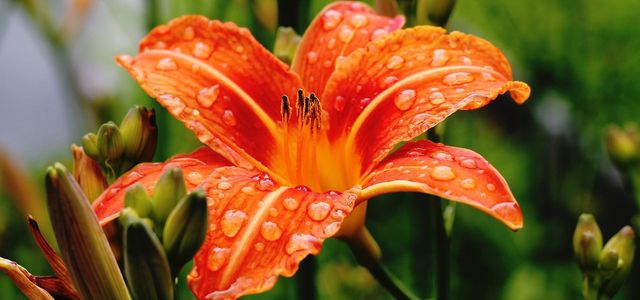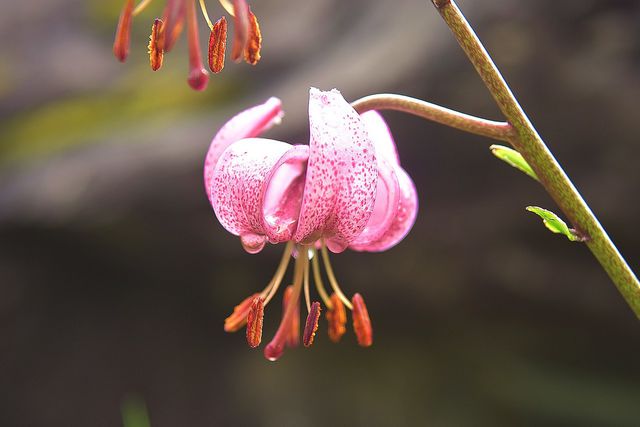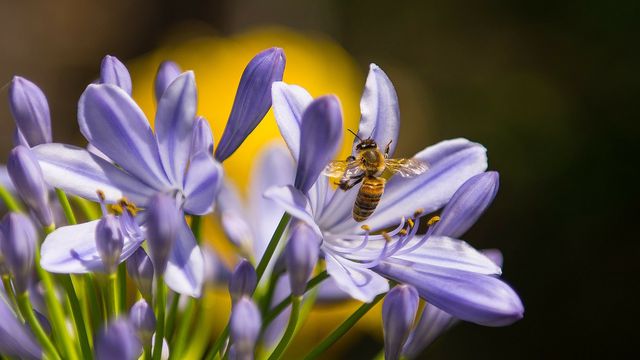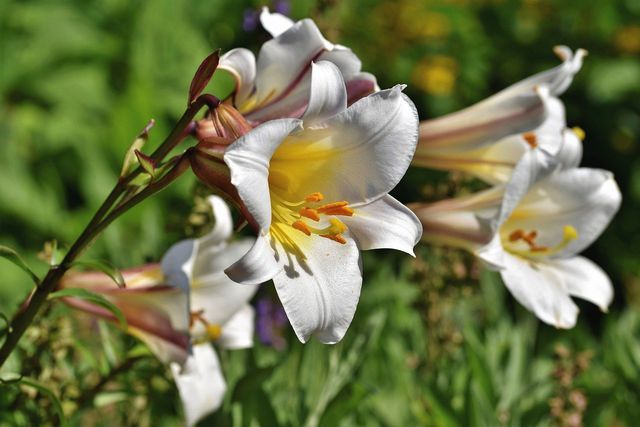
Lilies can be planted both in the garden and in pots. In this article you will learn how exactly to do this and what you should consider when caring for lilies.
If you want to plant lilies, you are already spoiled for choice when it comes to choosing the right variety. Of the more than one hundred different species, most lilies can be cultivated both in beds and in pots as flowering houseplants.
Their striking flowers, which vary greatly in shape and color, make the lily an eye-catcher. Originally from the Himalayan region, these popular ornamental plants can now be found in gardens and homes around the globe. We’ll show you everything you need to know when planting and caring for lilies – whether in pots or in the garden.
Contents
- 1 Planting lilies: The right varieties for outdoors and indoors
- 2 Planting lilies: In the pot and in the garden bed
- 3 In addition, you should consider the following tips when planting lilies:
- 4 Planting lilies in the bed:
- 5 Planting lilies in a pot:
- 6 Proper care for lilies in the pot and in the garden
- 7 Author
Planting lilies: The right varieties for outdoors and indoors

Just about every type of lily thrives in the garden, but not all lilies can be grown indoors without any problems. That’s why you should already make sure that you choose the lilies according to their location when you buy them in the garden shop.
Lilies that you can plant well in the garden:
Madonna Lilies
Turk’s-collar lilies
Fire lilies
King lilies
Coral lilies
Lilies that do well in pots and indoors:
Avignon
Cordelia
Marco Polo
Mona Lisa
By the way, the green lily is very good to plant in a pot, but it is not related to lilies.
Planting lilies: In the pot and in the garden bed

If you want to plant lilies, it is best to do it in the fall (September to November) or spring (late March to May). Note that unlike daffodils or tulips, lily bulbs do not have a strong outer skin. Therefore, you can not store them unprotected for a long time. The best thing to do is to go directly to the garden center for advice on the best time to plant your chosen lily.
In addition, you should consider the following tips when planting lilies:
Location: Depending on which species you choose, lilies have different requirements for their location. A sunny to semi-shady spot in the garden is usually ideal. The flowers in particular need a lot of sunlight, while the lower part of the plant can be quietly in partial shade. Annual summer flowers or low-growing cushion perennials, for example, work well to provide shade for the lily’s delicate leaves. Indoors, you should be aware that lilies in pots do not tolerate blazing sun too well. If you want to plant the lilies on the balcony, you should therefore place them in a place protected from wind and rain, facing west or southeast.
Soil: Lilies in pots feel most comfortable in standard potting soil. Alternatively, you can mix your own potting soil. Make sure that the soil is as loose as possible and has a high nutrient and humus content. In the garden, the soil should also be well-drained and rich in nutrients.
Planter: Lilies also look best in groups in a pot. The planter should be large enough in diameter to allow ten to 15 centimeters of space between the individual bulbs. The pot should also be about 20 centimeters high and have drainage holes through which excess water can run off.
Planting lilies in the bed:
- First dig a planting hole 25 to 30 inches deep.
- Fill a drainage layer of coarse gravel into the hole to prevent waterlogging later.
- Mix the excavated soil with some sand and compost.
- Add a five to ten centimeter layer of the compost-sand-soil mixture on top of the drainage.
- Now place the bulbs on this layer at intervals of ten to fifteen centimeters.
- Then fill the hole with the remaining soil.
- Lightly tamp down the surface and water the lilies generously.
Planting lilies in a pot:
- Place a drainage layer of pebbles at the bottom of the pot above the drainage hole.
- Cover the drainage with a thin layer of potting soil. Be sure to use peat-free soil to protect the bogs.
- Then place the lily bulbs on top of the soil. Keep a distance of at least ten centimeters between each bulb.
- Cover the bulbs with another layer of soil and lightly press the surface.
- Water the bulbs with plenty of water.
Proper care for lilies in the pot and in the garden

Depending on the species, you can enjoy the first flowers of your lilies between May and September. To ensure that the flowers are as lush as possible, both in the garden and in the home, it is essential that you care for the lilies properly after planting. If you follow a few tips, however, you’ll quickly realize that lilies are, in themselves, very low-maintenance house, garden and balcony plants.
Watering: Especially in the growth phase from March to September, lilies in the garden and in pots need a lot of water. With houseplants, it is especially important that the water can run off through drainage holes. You’ll also need to water and care for lilies regularly in the winter, making sure that the soil never dries out completely.
Fertilizing: You can fertilize lilies in the garden in spring before they sprout. Organic fertilizer with a low nitrogen content is best. Indoors, you will need to fertilize the plants more frequently. It is best to use a liquid fertilizer every four weeks from spring until flowering. Slow-release fertilizers in the form of fertilizer sticks are also very useful for potted lilies.
Pruning: Whether indoors or in a bed, regular pruning is not to be neglected when caring for lilies. After flowering, you should cut off the faded stems and inflorescences. In late summer or fall, you can then remove the withered leaves. Be sure to always use a clean, sharp knife for cutting.
Wintering: Lilies in pots are best kept in a cool cellar over the winter. Cut them down to the soil surface beforehand. In spring, repot the lilies and plant them in new soil. In the garden, too, it is best to cut them back thoroughly beforehand. Hardy species include the fire lily, the Madonna lily and Asian hybrids. The best way to protect them is to pile up some soil around the base of the stems and cover the plant with a layer of straw and twigs.
Diseases and pests: The lily bug is one of the biggest threats to your lilies. Especially its larvae can be dangerous to the leaves. Therefore, check your plants regularly from May onwards for this pest and spray the leaves with a jet of water from time to time.
Lilies as cut flowers: Lilies are particularly beautiful cut flowers that can last up to two to three weeks. It’s best to cut lilies in the garden just before they bloom in the early morning or evening hours. The ideal time is when the buds have already turned a rich color. Cut the lilies so that no more than half of the stem remains.
Caution: Lilies are considered poisonous plants for cats. To protect your pet, you as a cat owner:in should rather refrain from planting lilies in the pot or in the garden.

